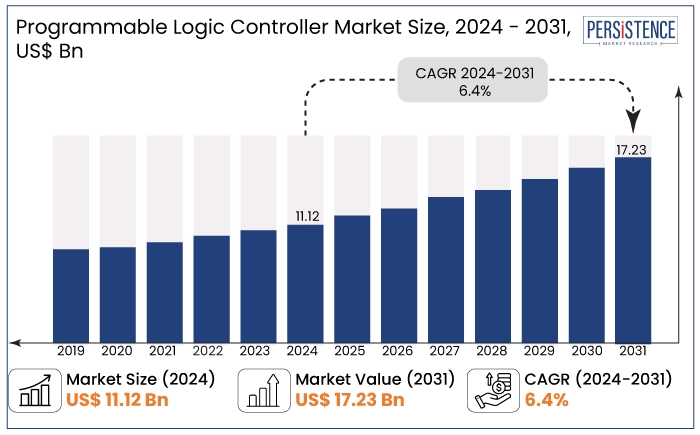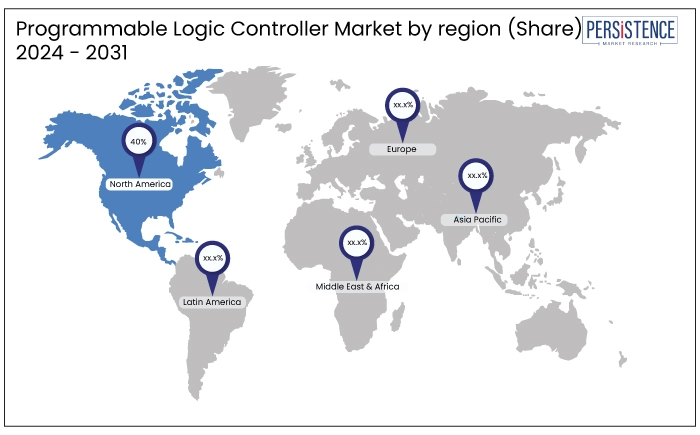Industry: Semiconductor Electronics
Published Date: November-2024
Format: PPT*, PDF, EXCEL
Delivery Timelines: Contact Sales
Number of Pages: 183
Report ID: PMRREP34922
The programmable logic controller market is estimated to increase from US$ 11.12 Bn in 2024 to US$ 17.23 Bn by 2031. The market is projected to record a CAGR of 6.4% during the forecast period from 2024 to 2031.
The manufacturing industry is increasingly adopting automation for efficiency and productivity. Industry 4.0 drives demand for Programmable Logic Controllers (PLCs) in smart factories and digital manufacturing applications. Integration of IoT and AI in PLCs is further enabling smarter, connected devices that offer real-time insights and predictive maintenance capabilities catering to revenue generation.

Key Highlights of the Market
|
Market Attributes |
Key Insights |
|
Programmable Logic Controller Market Size (2024E) |
US$ 11.12 Bn |
|
Projected Market Value (2031F) |
US$ 17.23 Bn |
|
Global Market Growth Rate (CAGR 2024 to 2031) |
6.4% |
|
Historical Market Growth Rate (CAGR 2019 to 2023) |
5.7% |
North America is projected to generate a programmable logic controller market share of 40% in 2024. The region houses several leading end-use industries that extensively utilize PLC technologies, including automotive, oil and gas, food and beverage, and manufacturing.
Various prominent PLC vendors have built their headquarters and principal research facilities in the region to efficiently serve clients. North America, equipped with unique industrial infrastructure and a competent workforce, offers an ideal environment for testing new PLC technologies.
The region has a sophisticated ecosystem of integrators and automation solution providers that assist diverse process sectors in designing and implementing tailored PLC-based systems. Rigorous regulatory regulations for industrial safety have accelerated PLC deployment in essential industry areas.
North America, characterized by its extensive and developed industries, anticipates ongoing enhancements and development of automation infrastructure, stimulating demand for PLCs. The region also has manufacturing capability for a substantial share of PLC hardware components, which reduces reliance on imports and logistics expenses for the supply network. Integrating industrial leadership, robust infrastructure, and established standards has enabled North America to sustain its dominance in the global programmable logic controller market.

|
Category |
Market Share in 2024 |
|
Type- Modular |
45% |
Based on type, the market is divided into modular, compact, and rack mounted. Out of these, modular type PLCs dominate the market. These are the most widely used types, especially in large-scale industrial applications. Their modular design allows users to broaden or customize the system by adding additional components such as input/output modules, power supplies, and communication modules.
It makes them ideal for industries requiring high flexibility and the ability to scale, such as automotive manufacturing, chemical processing, and oil and gas industries. The adaptability of modular PLCs, combined with advanced features like support for remote I/O and networking, has led to their dominance in the market.
|
Category |
Market Share in 2024 |
|
End Use- Manufacturing |
32% |
Based on end use, the market is segregated into aerospace and defense, automotive, chemical, energy and utilities, food and beverages, healthcare, manufacturing, mining and metal, oil and gas, and transportation. Among these, the manufacturing segment dominates the market.
The manufacturing industry is considered the largest consumer of PLCs, driven by the widespread adoption of automation technologies in industries such as automotive, electronics, and consumer goods. PLCs are used in assembly lines, robotics, process control, and production monitoring.
Growing shift toward Industry 4.0 and smart manufacturing, which relies on real-time data and automated processes, has further accelerated PLC adoption in this industry. Manufacturing processes across various industries, such as automotive, electronics, consumer goods, and machinery production, require high levels of automation for efficiency, precision, and safety.
PLCs are also essential for controlling machinery, robotics, conveyors, assembly lines, and packaging systems. These help in ensuring smooth and automated operations. PLCs also help streamline complex processes, improve production speeds, reduce human error, and enhance operational efficiency. These features make them a critical component in modern manufacturing environments.
A Programmable Logic Controller (PLC) is a compact computer capable of receiving data and providing operating directives via its inputs and outputs. Its function is to regulate the operation of a system based on the programmed logic it contains. Businesses globally utilize PLCs to automate their essential processes.
A PLC acquires data from automatic data capture sources and manual input devices such as switches and buttons. The PLC thereafter determines whether to modify the output according to its programming. The outputs of a PLC can regulate multiple devices, such as motors, solenoid valves, lighting, switchgear, safety shut offs, and others.
They also offer advanced solutions, encompassing automated production lines, energy consumption regulation, and security surveillance. These help in increasing the need for PLCs in the industrial automation sector.
The oil, gas, and automotive sectors are set to generate high market shares during the forecast period. There is an increasing demand for automation, especially in the paper and pulp, chemical and pharmaceutical, energy, and utility industries, which is anticipated to yield significant possibilities for PLC adoption on a large scale. For instance,
During the historical period from 2019 to 2023, the programmable logic controller market witnessed a CAGR of 5.7%. This growth was attributed to booming manufacturing, automotive, and oil and gas industries. These industries adopted automation technologies to improve efficiency and reduce costs.
In the historical period, the market players focused on traditional PLC systems, with modular and compact types dominating due to their scalability and flexibility. The integration of PLCs with SCADA and IoT technologies has now become more prevalent, enhancing real-time monitoring capabilities and predictive maintenance. ?
Over the forecast period, the PLC industry is predicted to surge even faster, driven by the acceleration of Industry 4.0 initiatives, rise of smart factories, and increasing adoption of IoT and AI technologies. This growth is particularly evident in industries like automotive, food and beverages, chemicals, and energy, where automation is critical to optimizing operations. ?
PLCs are becoming more specialized, with emerging trends like edge computing and advanced process control. Demand for highly compact and energy-efficient PLC solutions is set to rise, with significant growth in Asia Pacific, particularly in China and India. ?
Usability of PLCs to Propel the Global Programmable Logic Controller Market
PLCs are utilized to regulate industrial processes, encompassing assembly lines and robotic apparatus. These also encompass any task necessitating high-reliability control, programming ease, and process fault detection.
The PLC functions as more than a specialized digital computer across several industries and control-system domains. Its robust design and features include sequential control, programming simplicity, dependable control capabilities, and user-friendly hardware integration. Certain industrial facilities heavily utilize automation and can manage various controllers and equipment, while others lack familiarity with contemporary technologies.
PLCs serve as the prominent automation instrument across diverse sectors and applications. It offers reliable, accurate, and configurable control while being user-friendly because of its widespread application and familiarity.
Unlike other control units, a PLC can assess the condition of facilities and programs to identify any flaws or errors, enabling timely fixes. Input and output indicators are swiftly and effortlessly identified within the system.
PLCs can function in severe industrial conditions and operate among voltage fluctuations, temperature, humidity, and ambient noise. Ladder logic and other traditional PLC programming languages are familiar to automation technicians and maintenance personnel who frequently engage with PLCs. Several firms are coming up with new products to attract a large customer base. For instance,
Rising Implementation of Industrial Automation to Bolster Demand
The global manufacturing industry has swiftly embraced industrial automation technology over the last decade, which is primarily motivated by the necessity to improve productivity and operational efficiency in production processes across various industries.
Programmable logic controllers (PLCs) are essential components of industrial automation systems, offering the necessary processing and control functions to automate industrial processes and machines. PLCs are progressively used to automate various manufacturing processes, encompassing assembly line operations, material handling equipment, machine tools, and packaging machinery.
Increasing intricacy of production processes is driving demand for PLCs capable of managing more sophisticated control functions effortlessly. A growing number of factories are utilizing PLCs to get high flexibility in production through functionalities such as feedback control, motion control, and connectivity with other hardware.
Industries characterized by repetitive and mechanized processes, such as food and beverage, automotive, semiconductors, and electronics, have markedly enhanced their utilization of PLC-controlled machinery and equipment in recent years. Increasing demand for mass customization compels firms to implement PLC-controlled flexible manufacturing systems. Several industries' rigorous quality and reliability criteria are set to bolster the demand for automation through modern PLC systems. For instance,
Complexity in Integration with Legacy Systems May Hinder Demand
Integrating PLCs into older legacy systems remains a significant challenge for various manufacturers. Despite the flexibility and advantages of modern PLCs, the complexity of retrofitting new technology to work with outdated equipment can be a key obstacle.
Several industrial plants still rely on legacy control systems that may not be compatible with the latest PLCs. It creates a high degree of complexity when attempting to integrate PLCs into these environments. This is because it often requires extensive customization, specialized interfaces, or the replacement of entire systems.
Such integration efforts can incur high costs and significant downtime, both of which could be better for manufacturers seeking efficiency and cost-effectiveness. Furthermore, the potential for system incompatibility or the need for constant adaptation to evolving technology creates a reluctance to embrace PLCs in industries that are not yet fully modernized.
Cutting-edge Motion Control and Robotics Integration to Create Opportunities
Integrating PLCs with advanced motion control systems and robotics presents a key opportunity for market growth. As industries adopt more flexible manufacturing systems, PLCs are used to control robotic arms, autonomous mobile robots, and other motion-control mechanisms with greater precision.
With innovations in motion control technology, PLCs are becoming critical in applications requiring fine-tuned control over robotic systems, such as assembly lines and material handling. These systems are also adaptable, allowing manufacturers to reprogram and reconfigure production lines quickly, enhancing production flexibility.
The rise of automation in industries such as automotive, electronics, and consumer goods is further driving demand for PLCs. These can seamlessly integrate with cutting-edge robotic systems, enabling high productivity and reduced downtime.
The competitive landscape of the micro Programmable Logic Controller (PLC) industry features several dominant players, including Siemens AG, Rockwell Automation, ABB Ltd., Schneider Electric, and Mitsubishi Electric. These companies leverage product launches, technological innovations, partnerships, and acquisitions to maintain their dominance.
Siemens and Rockwell Automation are making significant strides in developing energy-efficient solutions and integrating unique automation capabilities into their PLC systems. Increasing demand for industrial automation and energy efficiency is fueling market growth, especially in regions like Asia Pacific, where industrialization is rapidly rising?.
Cybersecurity concerns present challenges as PLC systems become more interconnected, requiring firms to innovate and integrate robust security measures into their products. ?As the PLC industry continues to evolve, players are set to focus on enhancing connectivity, energy management, and user-friendly features. This strategy would help them to meet the rising demand for automation across industries.
Recent Industry Developments
|
Attributes |
Details |
|
Forecast Period |
2024 to 2031 |
|
Historical Data Available for |
2019 to 2023 |
|
Market Analysis |
US$ Billion for Value |
|
Key Regions Covered |
|
|
Key Market Segments Covered |
|
|
Key Companies Profiled in the Report |
|
|
Report Coverage |
|
|
Customization and Pricing |
Available upon request |
By Type
By Component
By End Use
By Region
To know more about delivery timeline for this report Contact Sales

It is anticipated to reach US$ 17.23 Bn by 2031.
Messung’s Meprolog-H PLC is made in India, which is the country’s first indigenous PLC.
Siemens AG, Rockwell Automation, Inc., and Mitsubishi Electric Corporation are the leading providers.
It helps control outputs and evaluate inputs to manage industrial processes.
Mitsubishi GX Works, Rockwell Automation's Studio 5000, and Siemens TIA Portal are the main software solutions.